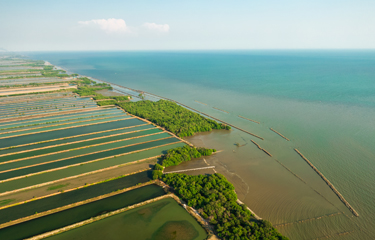Mangrove
A mangrove is a shrub or tree that grows in salty or brackish coastal waters. Mangrove species are highly diverse due to convergent evolution in various plant families. They are found worldwide in tropical and subtropical regions and even in some temperate coastal areas.



📊 Statistics
Mangroves are threatened by human activities, including coastal development, pollution, and over-harvesting. It is estimated that approximately 35% of the world’s mangroves have been lost in the past 50 years.
- Average height: 6 meters (record: 25 meters)
- Lifespan: 80 to 120 years
- CO₂ absorption: ~300 kg
How much CO₂ does a mangrove tree absorb?

Studies have shown that mangroves capture 2 to 4 times more carbon than mature tropical forests and have the highest carbon density of all land-based ecosystems.
Eden Projects has determined the average amount of CO₂ absorbed by one mangrove tree to be 308 kg (0.3 tons) of CO₂.
Habitat
Mangroves are highly salt-tolerant (also known as halophytes) and are adapted to survive in harsh coastal conditions. They thrive in oxygen-deprived environments of muddy swamps but grow best in the upper half of the intertidal zone.
Mangroves are found in 118 countries, with the largest mangrove areas located in Indonesia, Brazil, and Australia.

Applications of Mangroves
Mangroves provide protection to nearby populated areas by preventing erosion and absorbing storm surges during extreme weather conditions such as hurricanes. They are also crucial for the ecosystem, supporting fish and reptiles. Their dense roots help bind and build the soil.
Mangroves are not typically destroyed for timber or other purposes; they are mainly removed for coastal development. The most significant threat to mangrove forests is the rapid expansion of shrimp farming. Hectares of lush wetlands have been cleared to make way for artificial ponds teeming with shrimp.

More about the Mangrove
- There are approximately 80 species of mangroves.
- Worldwide, there are around 18 million hectares of mangrove land.
- Mangroves can be found in 118 countries.
- Mangroves offer a variety of ecosystem services; they protect coastlines from storms and erosion, sequester carbon, and provide habitat for fish and other wildlife.
Mangroves are frequently referred to as a ‘nature-based solution,’ a term often used to address the climate crisis. A nature-based solution leverages the inherent strengths existing in nature to mitigate or adapt to the impacts of change. One of the most significant strengths of mangroves lies in their ability to capture and store carbon.
The muddy soil in which mangroves thrive is extremely carbon-rich, and over time, mangroves not only help replenish this soil reservoir by trapping sediments but also keep it – and the carbon – in place. The amount of carbon stored beneath these trees is estimated to be up to four times greater than that of other tropical forests, making these coastal forests extraordinarily valuable in the fight against climate change.
Plant this tree


